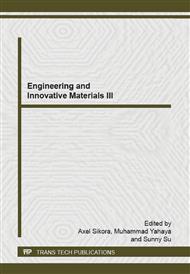p.237
p.242
p.247
p.252
p.258
p.263
p.268
p.273
p.278
Experimental Study of a Piezoelectric Rain Energy Harvester
Abstract:
Over the past few decades there has been significant advancement in the development of microelectronics. This has attracted attention of micro-scale energy harvester systems that could harvest energy from the operating environment of the microsystem. In this paper, rain energy harvesting using piezoelectric beam is tested. This paper seeks to create an experimentally validated proof of concept piezoelectric rain energy harvester using a piezoelectric beam. A rain simulator consists of six solenoid valves is designed to simulate different rain types. The effect of multiple water droplets impinging different positions on the piezoelectric beam is studied in this paper. Results show that a 4.5 ± 0.2 mm diameter water droplet falling at height of 0.82 m impinging the piezoelectric energy harvester is capable of generating a peak power of 0.16 mW.
Info:
Periodical:
Pages:
263-267
Citation:
Online since:
October 2014
Authors:
Keywords:
Price:
Сopyright:
© 2014 Trans Tech Publications Ltd. All Rights Reserved
Share:
Citation:


